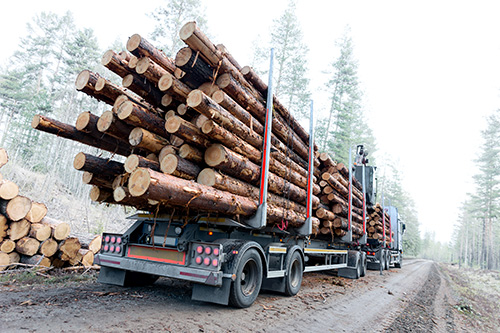GLOBAL TIMBER MARKET
- Europe’s sawlog market has been turbulent over the past three years, with wood demand falling, log flows shifting, and sawlog prices going through unprecedented swings. The European Sawlog Price Index (ESPI) fell 12% quarter-over-quarter (q-o-q) in the 3Q/23, with the most significant declines occurring in Central Europe.
- In the Nordic countries, prices have remained practically unchanged the past year except for Sweden, where spruce prices were up almost 10% from the 3Q/22 to the 3Q/23. The change was driven by a slowing of log deliveries by private forest owners, mostly in the southern region of the country.
- Sawlog prices fell in Central Europe during the first nine months of 2023 due to reduced production levels at the sawmills in Austria, the Czech Republic, and Germany.

GLOBAL WOOD FIBER MARKETS
- The supply of hardwood pulplogs tightened in 2023, primarily because of Russia’s invasion of Ukraine. This supply interruption has led to a 44% surge in the Global Hardwood Fiber Price Index (HFPI) since late 2020. This upward trajectory continued into the 3Q/23, during which the index reached its highest level in over ten years.
- In contrast to the hardwood market, the recent dynamics for softwood wood fiber have been different. Lower pulp production in North America and Europe and declining prices for softwood pulp globally have reduced demand for wood fiber. This decrease reduced the Softwood Fiber Price Index (SFPI) by 4.5% q-o-q in the 3Q/23.
- During the first eight months of 2023, hardwood chip trade in Asia declined substantially (over 12%), with China reducing purchasing by 26% year-over-year (y-o-y). Japanese pulpmills bucked the trend and had a strong 2023, with the most significant chip import volumes in four years.
GLOBAL LUMBER MARKETS
- Lumber trade has become more global over the past few decades with an increased flow of wood products from forest-rich countries to regions lacking domestic forests to supply the local markets. One good example is Sweden, where lumber manufacturers have expanded their sales far outside the markets they supplied in the past. Fifteen years ago, almost 80% of the country’s lumber export volume was shipped to European markets. That share has declined to about 55%.
- Combined softwood lumber production in Canada and the US in the first three quarters of 2023 totaled 73 million m3, down from 77 million m3 in the same period in 2022. Canada accounted for 25 million m3, and US production accounted for 48 million m3.
- Canada is still the top lumber supplier to the US, with 83% of the US market in 2023. However, volumes imported from Germany have steadily risen since 2019 to take almost 7% of the market share in 2023, and Swedish lumber now commands around 3% of the US lumber import market. The remaining 7% were smaller, supplying countries in Europe, Latin America, and New Zealand.
- Russia was the world’s largest exporter of softwood lumber in 2020 and 2021. In 2022, shipments fell dramatically because of Russia’s invasion of Ukraine and the boycott of Russian forest products. According to Wood Resources International, export volumes from Russia have dropped from a record high of over 31 million m3 in 2020 to less than 21 million m3 in 2023. Over the past year and a half, Russian lumber export prices have plunged by almost 50% in US dollar terms, from an all-time high of $310/m3 in early 2022 to $163/m3 in the 3Q/23.
- Log and lumber imports to China in the 4Q/23 increased from the previous quarter, but the estimated annual importation for 2023 was still the lowest in 11 years. The most significant decline in imports has been for logs, while lumber imports have fallen less in comparison over the past two years.
 GLOBAL BIOMASS MARKETS
GLOBAL BIOMASS MARKETS
- The US is the world’s largest wood pellet exporter, with shipments steadily increasing for over ten years. During the first nine months of 2023, export volumes were 7% higher than the same period in 2022, and the total for the year will likely be over 9.5 million tons, 50% more than five years ago.
- Residential wood pellet prices in Europe were substantially lower in the 4Q/23 than during the same quarter in 2022 after Russia’s invasion of Ukraine, which created much uncertainty in the European energy market. By the end of 2023, prices in Central Europe averaged €370/ton, their lowest level in almost two years. In Sweden, prices have fluctuated less, with only modest declines in 2023.
Wood Resource Quarterly has been digitized and is now available as an interactive online business intelligence platform, WoodMarket Prices. The pricing data service, established in 1988, has subscribers in over 30 countries. WoodMarket Prices tracks prices for sawlog, pulpwood, lumber, and pellets and reports on trade and wood market developments in most key regions worldwide. For more insights on the WoodMarket Prices platform, a unique and valuable tool for every organization that requires updates on the latest developments of global forest products markets, please go to www.resourcewise.com/platforms/woodmarket-prices.
Contact Information
Wood Resources International LLC, a ResourceWise Company
Hakan Ekstrom, Seattle, USA
 Hakan Ekstrom
Hakan Ekstrom
Wood Resources International LLC













